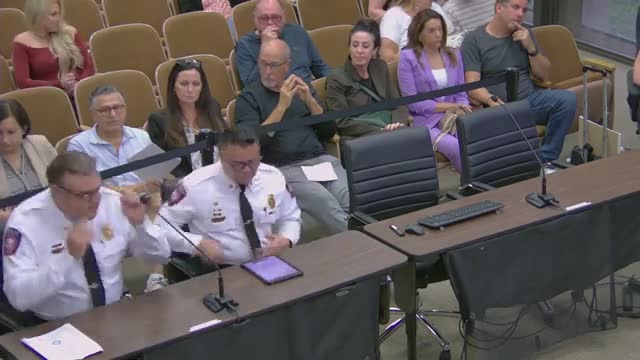Delray Beach fire officials outline role of All-Hazards Incident Management Team in regional responses
October 21, 2025 | Delray Beach, Palm Beach County, Florida
This article was created by AI summarizing key points discussed. AI makes mistakes, so for full details and context, please refer to the video of the full meeting. Please report any errors so we can fix them. Report an error »

Assistant Fire Chief David Garcia and Fire Chief Martin briefed the City Commission on Oct. 21 about Delray Beach’s participation in the Southeast Region All‑Hazards Incident Management Team (AHIMT), a cross‑agency incident management resource deployed under Florida’s state emergency response plan and the Emergency Management Assistance Compact (EMAC).
Garcia described the AHIMT as a multi-disciplinary, deployable cadre of personnel trained to national standards to fill incident-command roles including incident commander, operations, planning, logistics and finance/administration. "They coordinate resources, the information and they coordinate the communication," Garcia said, explaining the team’s role during hurricanes, wildfires, planned events and unplanned incidents.
Garcia and Chief Martin reviewed recent deployments by local staff that supported response efforts in Florida and other states, including teams that aided North Carolina after Hurricane Helene and missions to New Mexico during recent monsoon flooding. Garcia described how deployments are managed through the state, reimbursed after mission numbers are issued by the Florida Division of Emergency Management (FDEM), and documented under a resource-service agreement. "We do not release any of our resources until we get an actual FDEM mission number," Garcia said.
Commissioners asked how costs and reimbursements work; staff explained that some upticks in the emergency management budget were internal reclassifications of existing positions and some were new operational supplies. The city manager and chief said the city submits documentation, including labor, collective‑bargaining and emergency‑compensation policies, to FDEM for mission reimbursement. The city also referenced the Resource Service Agreement (RSA) that governs state commitments for reimbursement under statewide or interstate deployments.
Why it matters: The AHIMT increases Delray Beach’s capacity to lead or assist complex responses, helps coordinate multi‑agency logistics and supports documentation needed for federal and state reimbursement following major incidents.
Ending: Commissioners expressed appreciation for the program and asked staff to continue coordination with county, state and federal partners and to report back on deployments and budget implications when new missions arise.
Garcia described the AHIMT as a multi-disciplinary, deployable cadre of personnel trained to national standards to fill incident-command roles including incident commander, operations, planning, logistics and finance/administration. "They coordinate resources, the information and they coordinate the communication," Garcia said, explaining the team’s role during hurricanes, wildfires, planned events and unplanned incidents.
Garcia and Chief Martin reviewed recent deployments by local staff that supported response efforts in Florida and other states, including teams that aided North Carolina after Hurricane Helene and missions to New Mexico during recent monsoon flooding. Garcia described how deployments are managed through the state, reimbursed after mission numbers are issued by the Florida Division of Emergency Management (FDEM), and documented under a resource-service agreement. "We do not release any of our resources until we get an actual FDEM mission number," Garcia said.
Commissioners asked how costs and reimbursements work; staff explained that some upticks in the emergency management budget were internal reclassifications of existing positions and some were new operational supplies. The city manager and chief said the city submits documentation, including labor, collective‑bargaining and emergency‑compensation policies, to FDEM for mission reimbursement. The city also referenced the Resource Service Agreement (RSA) that governs state commitments for reimbursement under statewide or interstate deployments.
Why it matters: The AHIMT increases Delray Beach’s capacity to lead or assist complex responses, helps coordinate multi‑agency logistics and supports documentation needed for federal and state reimbursement following major incidents.
Ending: Commissioners expressed appreciation for the program and asked staff to continue coordination with county, state and federal partners and to report back on deployments and budget implications when new missions arise.
View full meeting
This article is based on a recent meeting—watch the full video and explore the complete transcript for deeper insights into the discussion.
View full meeting